|
By John Considine Coventry City FC and the Oakland A’s are not two teams one would usually group together. The former is an English League One football club while the latter is an American baseball franchise. However, both have legal battles hanging over their heads about planned relocations. The issues at stake highlight some of the differences between the American and European models of sport. With rare exceptions, there is no tradition of English football teams relocating whereas franchise relocation is a more normal feature of life in the US sports leagues. Now, a planned temporary move by an English football club could end up in Courts while delays with moving a baseball franchise has resulted in proceeding being issued. 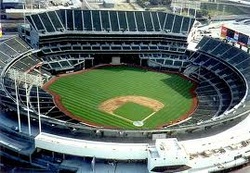 The twenty-first century has been a turbulent time for Coventry City. In 2001 it was relegated from the Premier League after over three decades of playing in the top flight of English football. In 2005 the team relocated to the larger capacity Ricoh Arena from Highfield Road. Two years later, it avoided being placed in administration when it was taken-over at the eleventh hour by SISU (a Hedge Fund). Unfortunately, another relegation for the club followed in 2012. In early 2013 the club entered administration. (The details of this particular administration are not the easiest to understand as it seems to involve separate elements of Coventry City.) As a result of the administration process the owners successfully applied to the Football League to play Coventry City’s home games at a new venue over 40 kilometres away for the next three years. The proposed move from the Ricoh Arena to Northampton’s Sixfields Stadium has brought the threat of legal action from the owners of the Ricoh Arena.
The stadium move was reluctantly approved by the Football League. The reluctance arises because the Football League does not want teams to move from the traditional areas from which the teams take their names. English football has been slower than US sport to see its sport primarily as a business. This is largely because the sport was governed by the FA that had responsibility for amateur and professional elements of the sport. Separation of the governance of different levels of the game was much slower to arrive in Europe than it was in America. And, these professional US leagues prioritised the business side of their sports to a greater degree. As a result, the number and location of teams is carefully regulated by the US leagues. In the US it is more common for teams to relocate. Location is a business decision. A team like the Baltimore Colts can move cities and become the Indianapolis Colts. Or the Montreal Expos can move cities and become the Washington Nationals. These moves are relatively common compared to the situation in English football (admittedly, Wimbledon moved and became the MK Dons but this was one of the very rare exceptions). If there is a better market for a franchise then the US Sports League will facilitate team relocation provided it does not clash with the interests of the other teams. Moreover, by keeping the number of teams lower than the number of cities wanting a team, the sports leagues can extract monopoly rents. For the last number of years it seems that the Oakland A’s wanted to move. Initially the proposed move was to Fremont. For the last four years they have signalled their intention to move to San Jose. San Jose have signalled their desire for the franchise. Now, San Jose believes the move is being hindered by potentially anticompetitive practices. As a result, they have taken Office of the Commissioner of Baseball to court to settle the issue. San Jose argue that MLB is the mechanism whereby teams divide up the market to maximise their interests. They argue that San Francisco Giants believe they have the territory rights over the San Jose area and that this is holding up the relocation of the Oakland A’s. It would be an overstatement to say that the whole structure of US sport is on trial. That said, the case does challenge the exemption baseball has from US antitrust law. The exemption is based on a 1922 decision by the Supreme Court. Ninety years ago the Supreme Court decided baseball did not involve interstate commerce and therefore was exempt from antitrust legislation. The decision was reaffirmed in 1953 and 1972. An unlikely success by San Jose could shake the US Sport Leagues to their core and make the Oakland A’s more famous in sports economics than did the book/movie Moneyball. What is more likely is that Oakland A's and Coventry City settle their dispute outside rather than inside the Court house and business continues as normal. By John Considine  Two features of the 2013 GAA hurling championship suggest that attendances will increase for the All-Ireland semi-finals between Dublin and Cork and between Limerick and Clare. First, the 2013 championship is more competitive than in previous years. Second, three of the counties with larger populations are in the semi-finals. One of the central tenets of sports economics is that, all else equal, spectators want greater competitive balance or outcome uncertainty. While the data to support this hypothesis is far from conclusive, there is little doubt that a situation where one team has a monopoly on titles does damage spectator interest. This is why today's defeat of a Kilkenny team that won 6 of the last 7 All-Ireland titles should be good for spectator interest. The All-Ireland semi-finalists are a unique combination in living memory. Dublin and Limerick enter the semi-finals as provincial winners. Both provincial wins should give their county support a significant shot in the arm. While Limerick and Dublin lie 4th and 5th in the roll of honour with 7 and 6 titles respectively, there is a huge gap between them and the top 3 of Kilkenny (34), Cork (30) and Tipperary (26).
The relatively early provincial defeats of Kilkenny and Tipperary, combined with their meeting in the early stages of the All-Ireland, boosted attendances in the earlier rounds. In the Irish Independent 10 days ago Martin Breheny said attendances were up by 39%. This is a welcome boost for the GAA who have been battling against the tide during the current financial crisis. While the 2013 quarter-finals attendance figures have been at the lower end of those since 2002 there was still a respectable 33,000 plus in Semple Stadium today. Since the introduction of the qualifier series in 2002, the largest quarter-finals attendance when the games were in Semple Stadium as a double-header was in 2008. That day 38,916 spectators watched Cork beat Clare and Waterford beat Wexford. The largest attendance at a single game quarter-final was in 2004 when 37,134 paid to see Kilkenny and Clare draw. The largest attendance at a quarter-final was for the double-header in 2007 where Cork played Waterford in one game and Limerick played Clare in the second game. There were 72,426 in Croke Park on the day. Cork and Waterford were also involved in the only other quarter-final to attract over 50,000 spectators. The 2006 game was a double-header with Clare and Wexford playing in the other game. Over 55,000 people paid in through the turnstiles in Croke Park on that day in 2006. It would be fair to say that a combination of the financial crisis and Kilkenny’s dominance contributed to the decline in numbers. It is not surprising that the games with larger attendances involve Cork. In addition to being one of the top-3 hurling counties in terms of titles, it is the second most populous county in the country. As of the 2011 population Census, Cork has a population of 519,032. In the All-Ireland semi-final Cork play Dublin – the most populous county with a population of 1,273,069. Limerick is the 5th most populous county. Therefore, three of the semi-finalists come from the largest “markets” for support. We will watch the attendances at the All-Ireland hurling semi-finals with interest. PS. Cork’s defeat of Kilkenny by 0-19 to 0-14 was the fourth lowest aggregate score in an All-Ireland quarter-final since the introduction of the qualifier series in 2002. Interestingly the other three also involve Kilkenny. There were the two games with Clare in 2004 and the game with Limerick in 2005. We all know what happened after that. 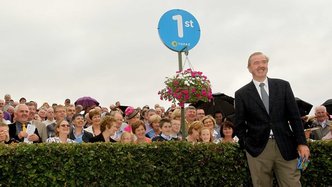 By Robbie Butler Monday sees the start of another Galway Festival and like last year, we are going to put Fama (1970) to the test. Fama’s groundbreaking article "Efficient Capital Markets: A Review of Theory and Empirical Work", which appeared in the May 1970 issue of the Journal of Finance conceptualized the efficient market hypothesis. Put simply, Fama concluded it was not possible to ‘beat the market’. The house always wins. We disagree and are prepared to put Fama to the test. Our confidence is based on prolificacy of the King on Ballybrit - Dermot Weld. Last year Dermot ran 34 horses over the seven day festival and despite the desperately soft ground, managed to saddle nine winners. A hypothetical stake of €1 (to win) on all runners returned a €4.28 profit. That’s a 12.5% return on all Weld trained horses over the seven days in 2012! Monday will see that start of our quest to, once again, ‘beat the bookies’. Daily updates to follow… Day 1: We are due to go to post for the first race at 5.10pm this evening. Six horses run for us tonight. Five are currently favourites and Notable Graduate is second favourite in Amateur Handicap at 6.45pm. We have a €1 win stake on all six and a €1 accume just in case we hit the jackpot. Total stake €7. Good luck DK Weld! Day 2: After getting off to a flyer yesterday thanks to Diplomat and Mustajeeb, we came back to earth with a bang with four subsequent losers and finish the day €2.35 behind. The day could have been much better if either Pay Day Kitten (finished 3rd but placed 2nd) or Marty’s Magic (2nd) had won. That said, we turn to day number two with optimism. Five runners today with Diplomat again leading the charge, his second run in 24 hours. Similar to yesterday DK saddles 4 favourites and 1 second favourite so plenty of chances in all races. We won’t panic about being behind so early. This strategy has worked seven times in the past ten years. Day 3: Fama certainly wins on day two. We took a hammering. Only odds-on favourite Tarfasha managed to stem the tide, easily winning the 6.10pm fillies race. Diplomat (3rd) and Dancers Dilemma (2nd) both came close to putting us ahead but neither managed to get their neck in front up the hill. Odds-on shot Pirate Cove and 11/4 favourite Tandem both ran disappointingly under the circumstances. Still, a long way to go yet and we won’t get too down. Our stake for the day was €6 with a return of just €1.50. That gives a loss of €4.50 on the day and, added to yesterday, has us €6.85 behind. Day 3 sees DK Weld saddle four horses. Galway Plate hopeful Majestic Concorde is the trainer’s only steeplechase horse in training. I’m not too optimistic on this one but who knows, it could spring a surprise. However, we have live chances in the 6.05pm, 6.40pm and 7.10pm. I’ll be on course tomorrow so hopefully our presence will bring a change of luck! Day 4: Our presence on-course has meant this post was delayed. We have some catching up to do. Day 3 proved to be ok despite a slow start. Lucky Kitten and Jayed Jidan ensured we were only just behind for the day. A stake of €6 saw a return of €4.45. However, still a loss on the day of €1.55. Added to our overall this has us behind by €8.40. However, Galway Hurdle day has been much kinder. DK sent four horses to post and despite Rock Critics disappointing show in the big race, both Yellow Rosebud (evens) and Treasure the Ridge (7/2) have delivered. At time of writing Don’t Tell No One has yet to race. On the day, so far we have a return of €6.50 from a €5 stake. A profit of €1.50 with one race let to run. Total loss is reduced to €6.90. Day 5: We finished in style yesterday when Don’t Tell No One easily won the Guinness Quarter Bumper with Robbie McNamara on board. Rock Critics’ disappointing run in the Galway Hurdle was the only thing that left us down for a 325-1 accume! A great day none the less. Total stake of €5, with a return of €10.25. A profit of €5.25. Taking this from our loss over the first three days, we are now just behind €3.15 behind. This loss is due to the four €1 accumes we have had each day, as insurance. Subtracting these would put us €0.85 ahead. Six horses today with lots of chances, although the ground is now far from ideal. Unaccompanied is one of DK's best horses in training. Her presence in the 7.25pm is surprising but exciting none the less. Despite ground concerns she should be far to classy for the opposition. Another good day could be in store. Day 6: The penultimate day of the Festival goes to post at 2pm today and we are in need of a recovery. Day 5 was a disaster. Only Unaccompanied delivered and at 1/2 did very little to stem the losses. Total stake of €6 with a €1.50 return. A loss of €4.50 on the day and a total net loss of €7.65. Six runners today including a surprising two in the 3.10. Let's hope Saturday is better than yesterday. Day 7: Days six and seven proved frustrating to say the least. The presence of two horses in the 3.10pm race prevented a €1 accume from being placed so the total stake was €6. Northern Rock delivered at 6-1 putting us €1 up on the day. Had either Mahon Falls or Leafcutter finished in front the day would have been a clear success. Overall loss after day six was €2.15. Day seven saw DK saddle just three horses. A total stake of€4 including our €1 treble. Notable Graduate won at evens and had the fast finishing Grecian Tiger (2nd) not been denied by 20-1 shot Merrion Row, the day would have been another success. Return of €2 meaning a loss of €2 on the day. Overall this resulted in a €4.15 loss on the week. However, subtracting our six €1 accume bets, following DK would have had you up €1.85! That’s a 4.6% return from following Weld trained horses over the seven day at Ballybrit. Not as good as 2012 but its DK Weld 2 – 0 Fama. Finally, three reflections on this year's Festival: 1. The recession continues to bit hard. There was no problem getting hotel rooms, booking dinner in city-centre restaurants, even getting taxis to and from the main spots. As late as Wednesday a friend of mine booked into a well-known 4-star hotel for Thursday night. Unheard of in previous years! 2. The Tiger does survive in dark corners. €9 for a beef roll under the Main Stand is a throwback from the days of Rip-off Ireland. The roll, which can be best described as an assault on the taste buds, was a ridiculous price. 3. DK Weld continues to be the King of Ballybrit. Following the county Kildare trainer would have led to a return of 4.6% (assuming equal stake on all Weld horses) over the course of the seven days. By Robbie Butler
On Wednesday the 7thof July the International Olympic Committee held a press conference in Lausanne, Switzerland where three cities, Istanbul, Madrid and Tokyo, made their pitch to host the 2020 Summer Olympic Games. The event passed off relatively unnoticed and the IOC will now continue their deliberations before announcing the winner in Buenos Aires this September. As with similar Games, the list of cities applying to host major sporting events continues to outstrip demand. For Madrid and Toyko it’s a case of déjá vu. Both applied unsuccessfully for the 2016 Summer Games. Madrid also applied for the 2012 Games. Baku and Doha have already been eliminated from the 2020 race, while Rome withdrew its bid on the eve of the deadline, citing financial reasons for their exit. Thankfully for all Italians, the Romans seem to be the only one of the six with any regard for the economic consequences of hosting the Games. If you talk to the bookies they’ll tell you the race is run. The Japanese capital is odds-on with all major betting chains. What might this mean for Tokyo and Japan? Well for one thing, their national debt is set to rise even further. The Japanese are second only to the United States when it comes to general government debt, with the current estimate just below $13 trillion, approximately $4 trillion less than the US. However, as a percentage of national output, Japan tops the global list of the most indebted countries on the planet, with a debt-to-GDP ratio of over 200%! So why would a country, already heavily indebted, want to burden itself with even more debt? The answer is simple and was confirmed at the 7th of July press conference by Japan’s Deputy Prime Minister Taro Aso. Mr Aso told the waiting media the Games were a chance for Japan to “rise up” from the 2011 tsunami, “strengthen”the “spirit” of all Japanese people and “show the rest of the world how far we have recovered”. He continued by stating a successful bid would provide “hope and encouragement for the future” for all Japanese citizens. In a nutshell, if Tokyo wins, the Japanese will be happier. Mr Aso would do the Japanese people and future generations a far better service if he tackled the countries crippling public debt. Unfortunately, this would probably get him booted out of office at the next election. Bringing the Summer Olympic Games to the Land of the Rising Sun is a certain vote-winner. The Spanish are in a similar precarious financial position. The last thing they need is further pressure on already strained public finances. Ironically, getting these games could be the worst thing to happen Istanbul, Madrid or Tokyo. Look no further than the Greeks. If governments want to make people happy, surely there are cheaper ways of doing so. Alternatively, they could all take a leaf out of the Italian’s book. After all wild-olive leaves, not gold medals, are the mark of the original Olympic champions. Governments should forget about spending billions of dollars on an extravagant ‘party’ and concentrate on what really matters. Now that would give us all “hope and encouragement for the future”. By Declan Jordan In Soccernomics (though I prefer the title on this side of the Atlantic - Why England Lose), Simon Kuper and Stefan Szymanski claim that Norway loves football most. This is based on participation rates, attendance at games and TV viewing of football. They don't have a similar study for clubs but there were reports last year that Manchester United were the most supported football club in the world with a fan base of 659 million fans. These results are very doubtful. It would mean 1 in 10 of the entire world population support Manchester United and the fan base is larger than the population of every country except India and China. The survey may be estimating awareness rather than support.  Social media is emerging as a new way to get insight into clubs' fan base. By no means are they without limitations. For example, I could follow Manchester City's twitter account to keep an eye on what the noisy neighbours are up to (I don't), which shows that following doesn't mean supporting in this context. Also. it is limited to those with twitter accounts or Facebook pages (and pc's and internet access). However, it is easier to get an indication of global reach and it indicates an active interest in a club rather than the passive awareness of one. On July 10 this year @manutd was launched as the verified Manchester United twitter account and the fund for the day was to watch the number of followers grow with each refresh. It is now at about 600,000 followers. This report from Forbes, which combines Facebook and Twitter followers and friends shows that Barcelona and Real Madrid are quite a distance ahead in social media popularity, followed by Manchester United after a large gap and then Chelsea, AC Milan and Arsenal. The only club from another sport competing with the latter clubs are the LA Lakers.
Reinforcing the idea in another Stefan Szymanski book - National Pastimes: How Americans play baseball and the rest of the world plays soccer - it is clear from the social media list just how the global reach for football outstrips that for large US sports franchises. Barcelona have more social media fans than the 30 most valuable major league baseball teams combined. This will prove to be an important source of data on clubs' off-field performance, especially as the data gets mined for interactions (such as Facebook likes and retweets on Twitter). By John Considine For the decade 2002-2011 a total of €1.38bn was spent on sport in Ireland by the Department of "Sport". Currently, sport is included in the Department of Transport, Tourism and Sport and it was previously under the Department of Arts, Sports and Tourism. It is this expenditure that we classify here as Exchequer expenditure on sport (it is known as Voted expenditure). It does not include funding via other government departments or via Local Authorities. Table 1 presents the Exchequer expenditure on sport and its decomposition for the period 2002-11. The amount is €1.38bn excluding the Horse and Greyhound Racing Fund (HGRF) and it rises to €2.05bn. It is debatable whether HGRF should be included. Even the government seems to be unsure about the correct classification of the HGRF. For almost half the decade 2002-11 public expenditure on the HGRF was included in the sports vote where as in the other years it was included in the Department of Agriculture vote. While what follows will exclude HGRF as sports expenditure it is worth briefly comparing the expenditure on the HGRF and that given the Irish Sports Council (ISC). Table 1 shows that current expenditure on HGRF was bigger than that for the ISC. In addition to the total expenditure on sport of €1.38bn over ten years, there are a number of feature of Table 1 worth noting. First, capital expenditure is larger than current expenditure. This is unusual in terms of total voted expenditure as current expenditure is a multiple of capital expenditure when one considers all voted expenditure. Second, there are a number of once-off items of capital expenditure. While it could be argued that much capital expenditure is once-off, the expenditure on Lansdowne Road and the Special Olympics are unlikely to be repeated in the decades to come. A somewhat similar argument could be made about the National Sports Campus where significant investment was made during a period when it seemed it was going to also have a stadium. Third, the two largest items namely Grants to Sporting Bodies and the Irish Sports Council account for over 70% of the expenditure. Fourth, Grants to Disadvantaged Area is given only a tiny proportion of the expenditure. The annual amount given to sport varied over the decade. The variation tended to be driven by once-off capital projects like the redevelopment of Lansdowne Road and the boom-bust cycle of recent patterns of expenditure by Irish governments. The increase and decrease in time profile of the expenditure in Table 1 are presented in Figure 1. For ease of comparison, the amounts are normalised to 100 for the first year of the decade under consideration. Gross expenditure, on all voted expenditure, was almost €36bn in 2002. It increased to 180% of it 2002 total by 2009 before starting to decline again as the government sought to address the fiscal crisis. Sport expenditure was almost €153m in 2002. It declines in 2003 to under 80% as the expenditure on Sports Campus Ireland collapsed from over €46m in 2002 to just over €6m in 2003, Sport expenditure only surpassed the 2002 level in 2007 and 2008 when it was driven by spending on the redevelopment of Lansdowne Road. Sport expenditure also seems to have suffered from the cuts to public expenditure that formed part of the government efforts to adjust it fiscal policy to a more sustainable one. It is possible to decompose the annual expenditure on sport among its component parts. This is done in Figure 2. Figure 2 shows the variability of the composition of sports expenditure. For example, in 2002 almost 40% of the expenditure on sport was devoted to the National Sports Campus and the Special Olympics. The amount devoted to these two items dropped dramatically in 2003 and virtually disappeared in 2004. While there is expenditure on redevelopment of Lansdowne Road in six of the ten years, the majority of that expenditure takes place in 2007 and 2008. In 2008 40% of all expenditure on sport goes to Lansdowne Road.
The relative constants in Figure 2 are the Irish Sports Council, Grants to Sporting Bodies, and Grants for Swimming Pools. The patterns in Figure 2 suggest that the Irish Sports Council is getting an increasing share of the sports allocation particularly since 2009. This is correct. However, it should be remembered that its share is increasing as the overall expenditure on sport is declining. In fact, the ISC share of sports expenditure since 2009 is increasing while the actual amount given to the ISC is declining. In 2009 the ISC received €51.7 and this declined to €44.5m in 2011. |
Archives
June 2024
About
This website was founded in July 2013. Categories
All
|
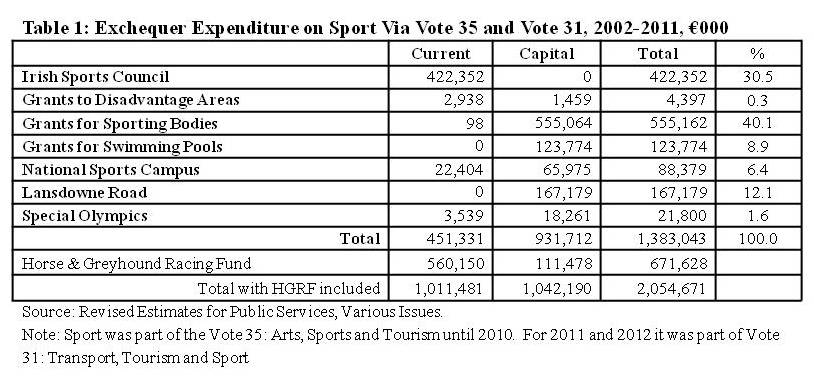
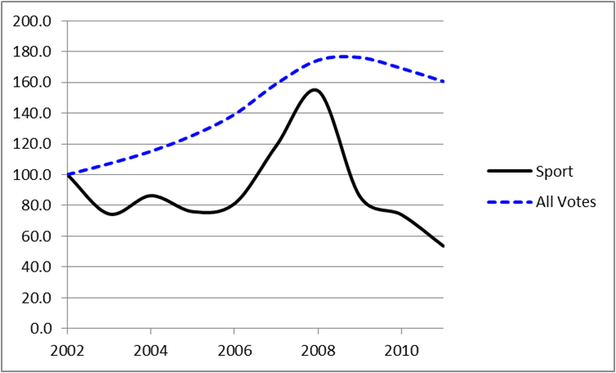
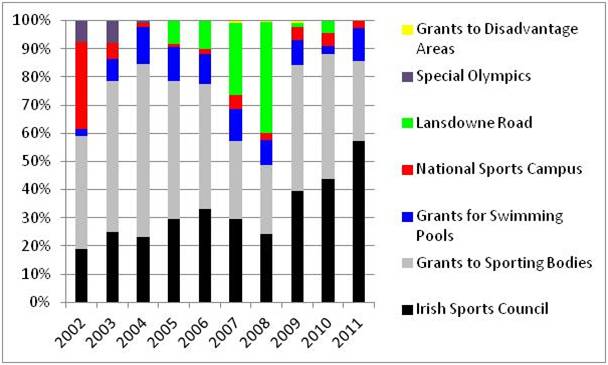
 RSS Feed
RSS Feed